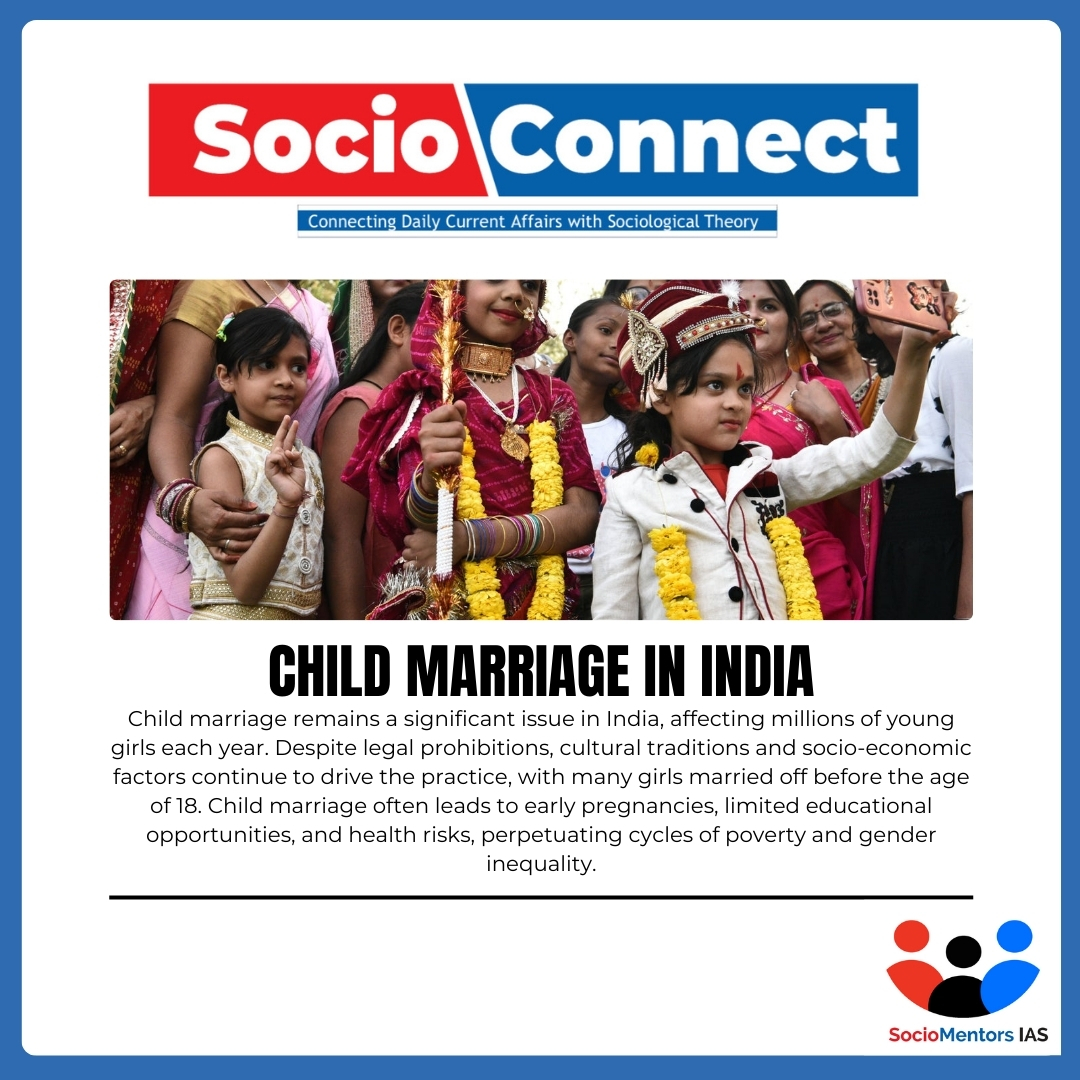Child Marriage in India – Sociological Perspective
July 5, 2024
Child marriage among girls is defined as any formal marriage or informal union under the age of 18 years. Recent studies report that the pattern of child marriage prevalence is often cut across sociocultural boundaries of the country. For instance, women’s position in Bengali society is considered to be higher compared to North Indian society. However, evidence suggests that West Bengal is one of the highest child marriage prevalence states of India in recent times.
Reasons for high prevalence rates of child marriages
- Poverty: Women belonging to the poorest (44.6%) and poorer (36.3%) wealth quintiles have a substantially higher prevalence of child marriage compared to women from the richer (19.6%) and richest (9.5%) wealth quintiles. For example, Murshidabad, one of the economically poorer districts of the State, has one of the highest numbers of child marriages in West Bengal. The NFHS – 5 points out that 55.4% of women aged 20-24 years are married before the age of 18 years in the district.
- Dowry demands: In India, the increasing dowry demand reinforces the practice of child marriage. For instance, parents generally married off their daughter at an early age because the amount of dowry will be high if she becomes older (Caldwell et al., 1983).
- Male meta preference: In patriarchal countries like India where the desire for children is high, especially male children, the younger brides are preferred because they have longer reproductive span to produce children and they can easily be controlled (Jensen & Thornton, 2003).
- Patriarchal Mindset and Protecting Purity: Parents also believe that marriage at an early age protects their daughter from premarital sexual activity, sexual abuse, unwanted pregnancies and sexually transmitted diseases.
- Child marriage and migration: Child marriages are prevalent in areas with migration of male population and they don’t want to leave unmarried daughters at home. Also, the men who are married to these girls want their wives to have children when they go out for work as is seen in the case of Sugarcane belt of Maharashtra and areas of Bengal with high migratory population.
Sociological Analysis of Child Marriage:
- According to the social exchange theory, social behavior is the result of an exchange process in which people weigh the potential benefits and risks of relationships. People are motivated to maximize benefits and minimize costs, and relationships form, continue, or dissolve based on the perceived worth of the exchange. In the context of child marriage, the social exchange theory suggests that the decision to marry a child is based on the perceived benefits and costs of the marriage for the parties involved. For example, parents may marry off their children at an early age to gain economic or social advantages, such as securing a dowry or strengthening family ties .
- Patriarchy allows child marriage to flourish by promoting gender inequality and oppressing women. In patriarchal societies, girls are often seen as inferior to boys and are valued according to their virginity. This leads to limits on female sexuality and reproductive choices. Also, patriarchal structures can lead to economic dependence on men, making families more likely to view their daughters as economic burdens. In such contexts, families may choose to marry off their daughters early to transfer the economic responsibility to the husband’s family.
- According to the conflict theory, child marriage is a result of the conflict between two social classes. The powerful class, are seen as oppressing the Proletariat. In most cases, a girl’s parents especially the male is more powerful in the family and enforces the girl child who is powerless to marry an older guy stripping her from her right to be a child. Moreover, after marriage, the husband carries on the legacy by taking full and complete control over his wife’s life aspects and decisions.
- The social learning theory suggests that people learn new behaviors, values, and attitudes through observation, imitation, and modeling of others. In the context of child marriage, this theory suggests that children learn about gender roles, marriage, and sexuality from their parents, peers, and media. Children may internalize the norms and expectations of their culture and community, and conform to them even if they are harmful or unjust. For example, if a girl grows up in a society where early marriage is common and celebrated, she may perceive it as a desirable and legitimate option for herself .
Socio-Discourse*
1. In the context of globalization, how do civil society groups in India navigate the tension between local and global interests?
2. How do civil society organizations use media and communication strategies to shape public opinion and influence policy in India?



